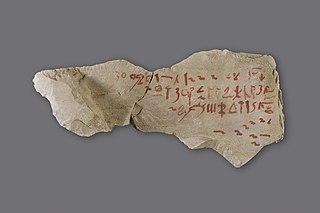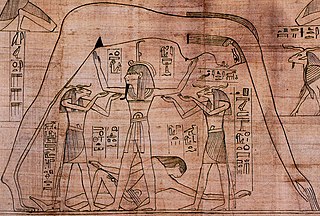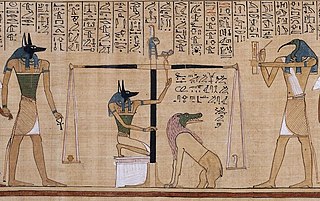
Thoth is an ancient Egyptian deity. In art, he was often depicted as a man with the head of an ibis or a baboon, animals sacred to him. His feminine counterpart was Seshat, and his wife was Ma'at. He was the god of the moon, wisdom, knowledge, writing, hieroglyphs, science, magic, art and judgment.

Nut, also known by various other transcriptions, is the goddess of the sky, stars, cosmos, mothers, astronomy, and the universe in the ancient Egyptian religion. She was seen as a star-covered nude woman arching over the Earth, or as a cow. She was depicted wearing the water-pot sign (nw) that identifies her.

Canopic jars are containers that were used by the ancient Egyptians during the mummification process, to store and preserve the viscera of their owner for the afterlife. They were commonly either carved from limestone, or were made of pottery. These jars were used by the ancient Egyptians from the time of the Old Kingdom, until the time of the Late Period or the Ptolemaic Period, by which time the viscera were simply wrapped and placed with the body. The viscera were not kept in a single canopic jar: each jar was reserved for specific organs. The term canopic reflects the mistaken association by early Egyptologists with the Greek legend of Canopus – the boat captain of Menelaus on the voyage to Troy – "who was buried at Canopus in the Delta where he was worshipped in the form of a jar". In alternative versions, the name derives from the location Canopus in the western Nile Delta near Alexandria, where human-headed jars were worshipped as personifications of the god Osiris.

The tomb of Tutankhamun, also known by its tomb number, KV62, is the burial place of Tutankhamun, a pharaoh of the Eighteenth Dynasty of ancient Egypt, in the Valley of the Kings. The tomb consists of four chambers and an entrance staircase and corridor. It is smaller and less extensively decorated than other Egyptian royal tombs of its time, and it probably originated as a tomb for a non-royal individual that was adapted for Tutankhamun's use after his premature death. Like other pharaohs, Tutankhamun was buried with a wide variety of funerary objects and personal possessions, such as coffins, furniture, clothing and jewelry, though in the unusually limited space these goods had to be densely packed. Robbers entered the tomb twice in the years immediately following the burial, but Tutankhamun's mummy and most of the burial goods remained intact. The tomb's low position, dug into the floor of the valley, allowed its entrance to be hidden by debris deposited by flooding and tomb construction. Thus, unlike other tombs in the valley, it was not stripped of its valuables during the Third Intermediate Period.

The Papyrus of Ani is a papyrus manuscript in the form of a scroll with cursive hieroglyphs and color illustrations that was created c. 1250 BCE, during the Nineteenth Dynasty of the New Kingdom of ancient Egypt. Egyptians compiled an individualized book for certain people upon their death, called the Book of Going Forth by Day, more commonly known as the Book of the Dead, typically containing declarations and spells to help the deceased in their afterlife. The Papyrus of Ani is the manuscript compiled for the Theban scribe Ani.

Sir Ernest Alfred Thompson Wallis Budge was an English Egyptologist, Orientalist, and philologist who worked for the British Museum and published numerous works on the ancient Near East. He made numerous trips to Egypt and the Sudan on behalf of the British Museum to buy antiquities, and helped it build its collection of cuneiform tablets, manuscripts, and papyri. He published many books on Egyptology, helping to bring the findings to larger audiences. In 1920, he was knighted for his service to Egyptology and the British Museum.

Tomb KV15, located in the Valley of the Kings in Egypt, was used for the burial of Pharaoh Seti II of the Nineteenth Dynasty. The tomb was dug into the base of a near-vertical cliff face at the head of a wadi running southwest from the main part of the Valley of the Kings. It runs along a northwest-to-southeast axis, comprising a short entry corridor followed by three corridor segments, which terminate in a well room that lacks a well, which was never dug. This then connects with a four-pillared hall and another stretch of corridor that was converted into a burial chamber.

A hypocephalus is a small disk-shaped object generally made of stuccoed linen, but also of papyrus, bronze, gold, wood, or clay, which ancient Egyptians from the Late Period onwards placed under the heads of their dead. The circle was believed to magically protect the deceased, cause the head and body to be enveloped in light and warmth, making the deceased divine. It replaced the earlier cow-amulet.

Instruction of Amenemope is a literary work composed in Ancient Egypt, most likely during the Ramesside Period ; it contains thirty chapters of advice for successful living, ostensibly written by the scribe Amenemope son of Kanakht as a legacy for his son. A characteristic product of the New Kingdom "Age of Personal Piety", the work reflects on the inner qualities, attitudes, and behaviors required for a happy life in the face of increasingly difficult social and economic circumstances. It is widely regarded as one of the masterpieces of ancient near-eastern wisdom literature and has been of particular interest to modern scholars because of its similarity to the later biblical Book of Proverbs.

Henutmehyt was the name of a Theban priestess of ancient Egypt, who lived during the 19th Dynasty, around 1250 BC. The excessive use of gold, and the high quality and detail of her coffins indicates that Henutmehyt was a wealthy woman.

TT1 is the burial place of the ancient Egyptian official Sennedjem and members of his family. It is located in Deir el-Medina, on the west bank of the Nile opposite Luxor.

The Department of Ancient Egypt is a department forming an historic part of the British Museum, with Its more than 100,000 pieces making it the largest and most comprehensive collection of Egyptian antiquities outside the Egyptian Museum in Cairo.

The Gebelein predynastic mummies are six naturally mummified bodies, dating to approximately 3400 BC from the Late Predynastic period of Ancient Egypt. They were the first complete predynastic bodies to be discovered. The well-preserved bodies were excavated at the end of the nineteenth century by Wallis Budge, the British Museum Keeper for Egyptology, from shallow sand graves near Gebelein in the Egyptian desert.

Animal mummification was common in ancient Egypt. Animals were an important part of Egyptian culture, not only in their role as food and pets, but also for religious reasons. Many different types of animals were mummified, typically for four main purposes: to allow people's beloved pets to go on to the afterlife, to provide food in the afterlife, to act as offerings to particular deities, and because some were seen as physical manifestations of specific deities that the Egyptians worshipped. Bastet, the cat goddess, is an example of one such deity. In 1888, an Egyptian farmer digging in the sand near Istabl Antar discovered a mass grave of felines, ancient cats that were mummified and buried in pits at great numbers.

The Lion-Hunts of Amenhotep III During the First Ten Years of his Reign is one of a group of five historical and commemorative scarabs made during the reign of Amenhotep III. The set of five scarabs were presumably used to validate, and proclaim his choice of Tiye as his wife.

Hornedjitef was an ancient Egyptian priest in the Temple of Amun at Karnak during the reign of Ptolemy III. He is known from his elaborate coffins, mummy mask and mummy, dating from the Early Ptolemaic Period and excavated from Asasif, Thebes, Egypt, which are all held in the British Museum. These related objects were chosen as the first of the hundred objects selected by British Museum Director Neil MacGregor in the 2010 BBC Radio 4 series A History of the World in 100 Objects.

The Greenfield papyrus is a papyrus that contains an ancient Egyptian Book of the Dead and is named after Mrs. Edith Mary Greenfield, who presented it to the Trustees of the British Museum in May 1910. Now in the collections of the British Museum, London, it is one of the longest papyri in existence with a length of 37 metres.

Ancient Egyptian afterlife beliefs were centered around a variety of complex rituals that were influenced by many aspects of Egyptian culture. Religion was a major contributor, since it was an important social practice that bound all Egyptians together. For instance, many of the Egyptian gods played roles in guiding the souls of the dead through the afterlife. With the evolution of writing, religious ideals were recorded and quickly spread throughout the Egyptian community. The solidification and commencement of these doctrines were formed in the creation of afterlife texts which illustrated and explained what the dead would need to know in order to complete the journey safely.
Muhammad Mohassib (1843–1928) was an Egyptian antiquities dealer in Luxor, Egypt. He began working as a young donkey boy to Lucie, Lady Duff-Gordon and learned English from her. He opened an antiquities shop in Luxor in the early 1880s and became well-known among especially British and French archaeologists and dealers. A lot of important collections in museums in Europe and the US were partly bought from Mohassib. For example, the Museum of Fine Arts, Boston (US) purchased a "Head of a King" from Mohassib in 1904.

The tomb of Tutankhamun was discovered in the Valley of the Kings in 1922 by excavators led by the Egyptologist Howard Carter, more than 3,300 years after his death and burial. Whereas the tombs of most pharaohs were plundered by graverobbers in ancient times, Tutankhamun's tomb was hidden by debris for most of its existence and therefore not extensively robbed. It thus became the first known largely intact royal burial from ancient Egypt. To date, the discovery of Tutankhamun's tomb is widely considered one of the most famous archaeological discoveries of all time.



















